Deep within the lush canopies of Central American rainforests lives a creature so vividly colored that it seems to have emerged from a child’s imagination rather than nature’s palette. The red-eyed tree frog (Agalychnis callidryas) stands out as one of the most visually striking amphibians on our planet, with a combination of colors so bold and contrasting that they almost appear artificial. Despite being just 2-3 inches in length, these small frogs command attention with their lime-green bodies, striking blue-and-yellow striped sides, orange feet, and their most distinctive feature – large, bulging red eyes that seem to glow against their emerald skin.
What makes this rainforest jewel particularly fascinating is that its spectacular coloration isn’t just for show – it serves critical survival functions in the complex ecosystem of the tropical rainforest. The red-eyed tree frog has become an iconic symbol of rainforest conservation efforts worldwide, appearing on countless nature magazine covers, documentary films, and conservation campaigns. Its almost surreal appearance challenges our understanding of natural selection and evolutionary adaptations while reminding us of the extraordinary diversity that thrives in our planet’s most complex ecosystems.
Taxonomy and Classification: A Tree Frog Like No Other
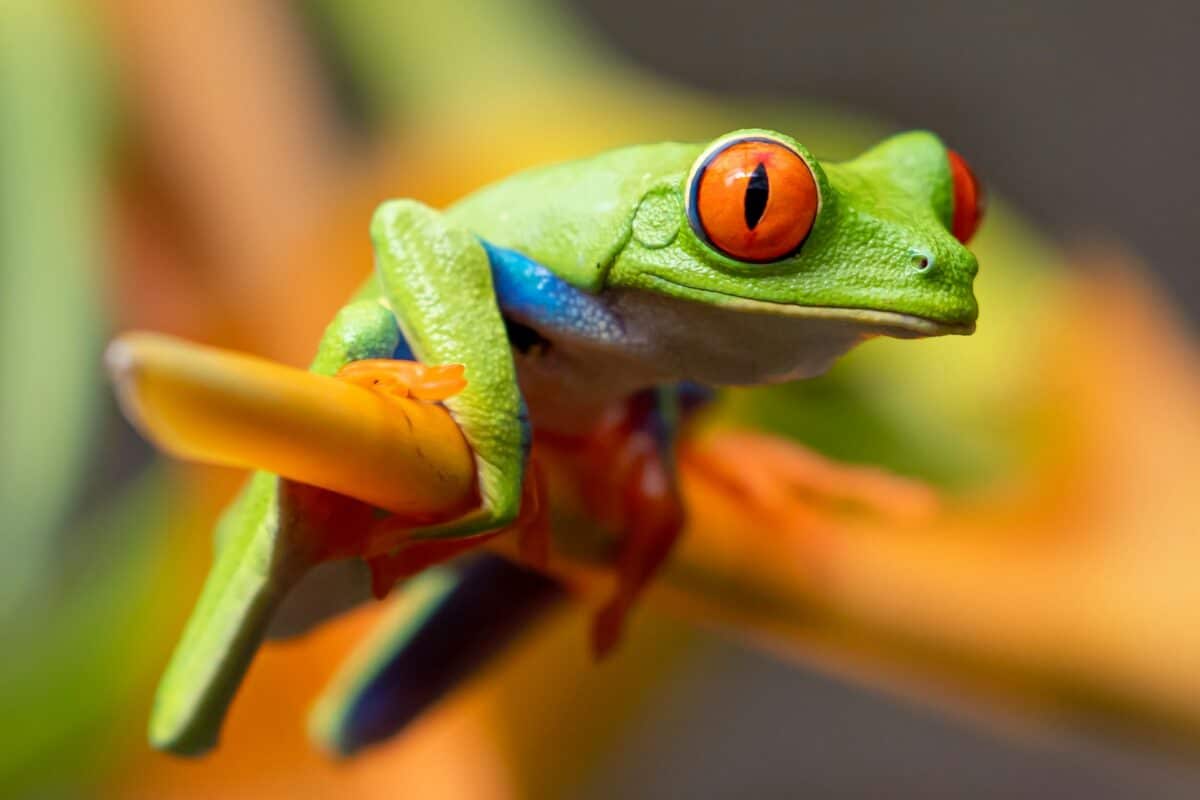
The red-eyed tree frog belongs to the family Hylidae, which encompasses most of the world’s tree frogs. Scientifically classified as Agalychnis callidryas, it falls within the subfamily Phyllomedusinae, a group known for their unique sideways walking behavior rather than hopping. Despite their amphibian classification, these creatures are often mistakenly identified as reptiles due to their exotic appearance and arboreal lifestyle. The genus Agalychnis includes several similar species, but the callidryas stands apart with its particularly vibrant coloration.
Evolutionary biologists have long been fascinated by this species, as it represents a perfect example of both camouflage and startle coloration working in tandem. When at rest with its eyes closed and limbs tucked close to its body, the frog appears almost entirely green, blending seamlessly with the foliage. However, when threatened, it reveals its spectacular hidden colors in a defensive display that has evolved over millions of years to confuse and deter predators. This sophisticated evolutionary strategy places the red-eyed tree frog in a special category of animals that employ multiple defensive techniques simultaneously.
Geographical Distribution and Habitat

Red-eyed tree frogs inhabit the neotropical rainforests stretching from southern Mexico through Central America to northern Colombia. They thrive particularly in the lowland rainforests of Costa Rica, Nicaragua, Panama, and Honduras, where the combination of high humidity, abundant rainfall, and dense vegetation creates the perfect environment for these arboreal amphibians. Within these ecosystems, they primarily occupy the middle and upper canopy layers, where they can find both protection from ground predators and proximity to their insect prey.
Their specific microhabitat consists of broadleaf trees near water sources, where females can descend to lay their eggs on leaves overhanging ponds or slow-moving streams. This careful habitat selection ensures that when the eggs hatch, the tadpoles can drop directly into the water below. The fragile nature of this habitat dependency makes red-eyed tree frogs particularly vulnerable to deforestation and habitat fragmentation, as they require both healthy forest canopy and clean water sources within close proximity – a combination increasingly rare in many parts of Central America due to agricultural expansion and logging activities.
The Science Behind the Spectacular Colors
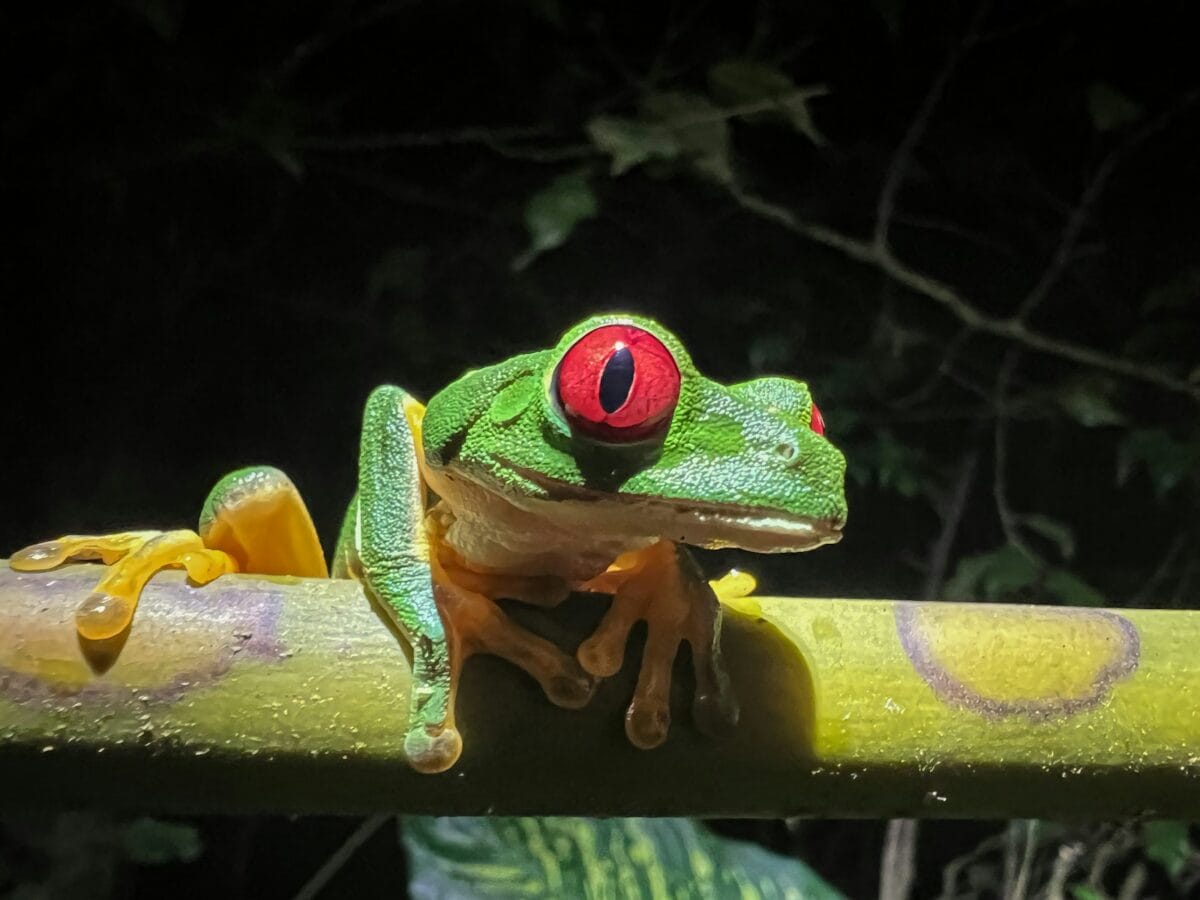
The red-eyed tree frog’s extraordinary coloration isn’t merely a product of random genetic variation but represents millions of years of evolutionary adaptation. The vibrant green that covers most of its body comes from specialized pigment cells called chromatophores, specifically xanthophores that contain yellow pigments and guanophores that reflect blue light. When these layers overlap, they create the bright green that allows the frog to blend perfectly with leaves. The blue striping along the sides results from light-reflecting structural colors rather than actual blue pigment – similar to how a butterfly’s wings create iridescent colors.
Perhaps most striking are the frog’s namesake red eyes, created by a thin layer of red pigment in the iris that overlays a reflective layer beneath. This combination produces the intense, seemingly glowing red that has made these frogs famous. Interestingly, the brilliant coloration serves dual functions: when the frog sleeps during the day with its eyes closed and colorful legs tucked under its body, it appears almost entirely green, becoming nearly invisible against leaves. When threatened, it suddenly displays its red eyes and bright blue-and-yellow flanks in a startling transformation that can momentarily confuse predators – a perfect example of what biologists call “startle coloration.”
Flash Coloration: Nature’s Surprise Defense Mechanism
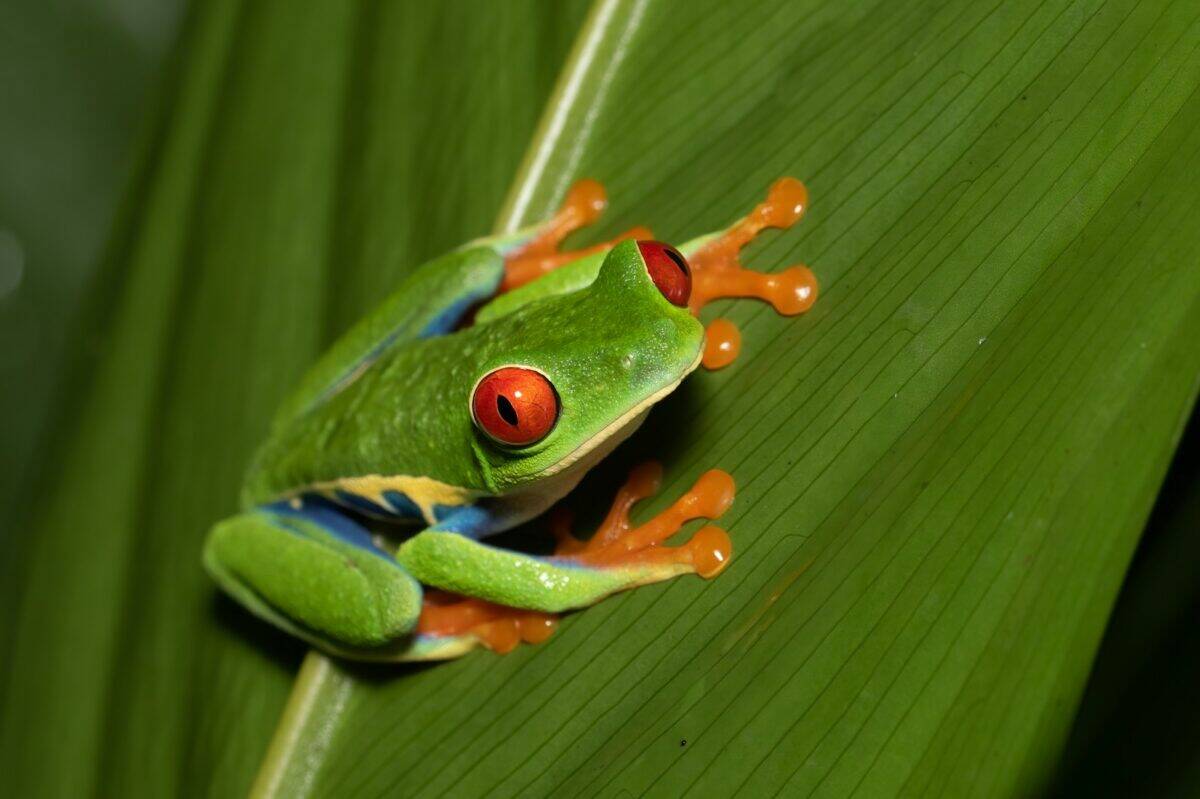
The red-eyed tree frog employs one of nature’s most ingenious defensive strategies: flash coloration. During daylight hours, when most predators are active, the frog remains motionless with its eyes closed and limbs tucked close to its body, appearing as nothing more than a green bump on a leaf. This camouflage strategy makes it virtually invisible to passing birds and snakes. However, when disturbed or threatened, the frog instantly reveals its startling red eyes and the bright blue and orange patterns on its legs and sides – colors that were completely hidden moments before.
This sudden display of vibrant colors often startles potential predators, creating a crucial moment of confusion or hesitation that gives the frog precious seconds to make its escape. Researchers believe this strategy is particularly effective because the sudden appearance of bright colors triggers an instinctive caution in predators, who often associate bright coloration with toxicity in the rainforest. Interestingly, unlike many other brightly colored frogs, the red-eyed tree frog isn’t poisonous – it merely mimics the warning coloration of toxic species. This sophisticated deception represents one of the most elegant examples of evolutionary adaptation in the animal kingdom.
Nocturnal Lifestyle and Hunting Behavior
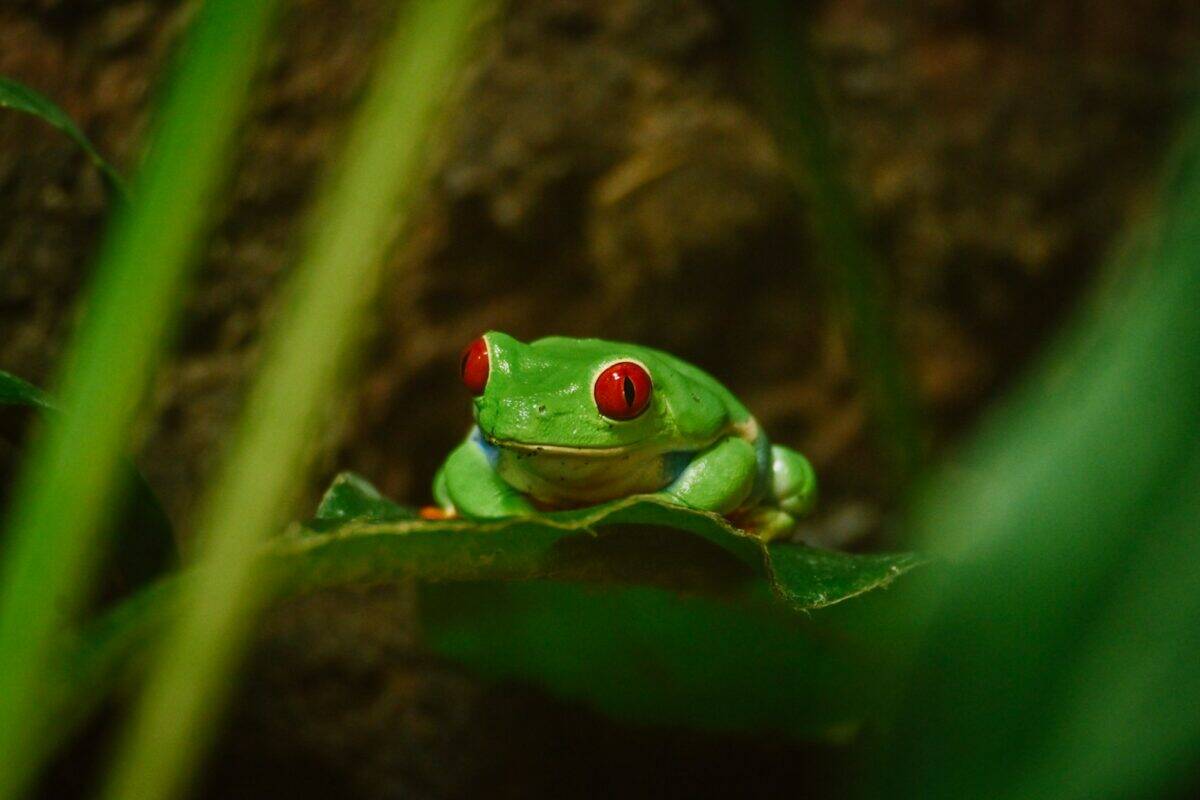
Red-eyed tree frogs are primarily nocturnal, becoming active after sunset when the rainforest transforms into a different world. During daylight hours, they sleep adhered to the undersides of leaves with their vibrant colors concealed. Their large red eyes, which appear so striking during the day, serve a crucial practical purpose at night – they provide excellent vision in low-light conditions, allowing the frogs to spot both prey and predators in the darkness of the forest canopy. Their vertical pupils can dilate widely to capture maximum light, giving them a significant advantage in their nocturnal hunting.
When hunting, these frogs rely on a combination of excellent vision and explosive movement. They primarily feed on crickets, flies, moths, and other small invertebrates that they encounter while moving through the canopy. Unlike some frogs that sit and wait for prey, red-eyed tree frogs actively patrol their territory, using their remarkable jumping ability to move between branches and leaves. When they spot suitable prey, they can launch themselves with surprising accuracy, capturing insects with their sticky tongues that can extend almost the length of their body. This active hunting strategy requires not only good vision but also the specialized toe pads that allow them to move confidently through the three-dimensional environment of the forest canopy.
Remarkable Adaptations for Arboreal Life
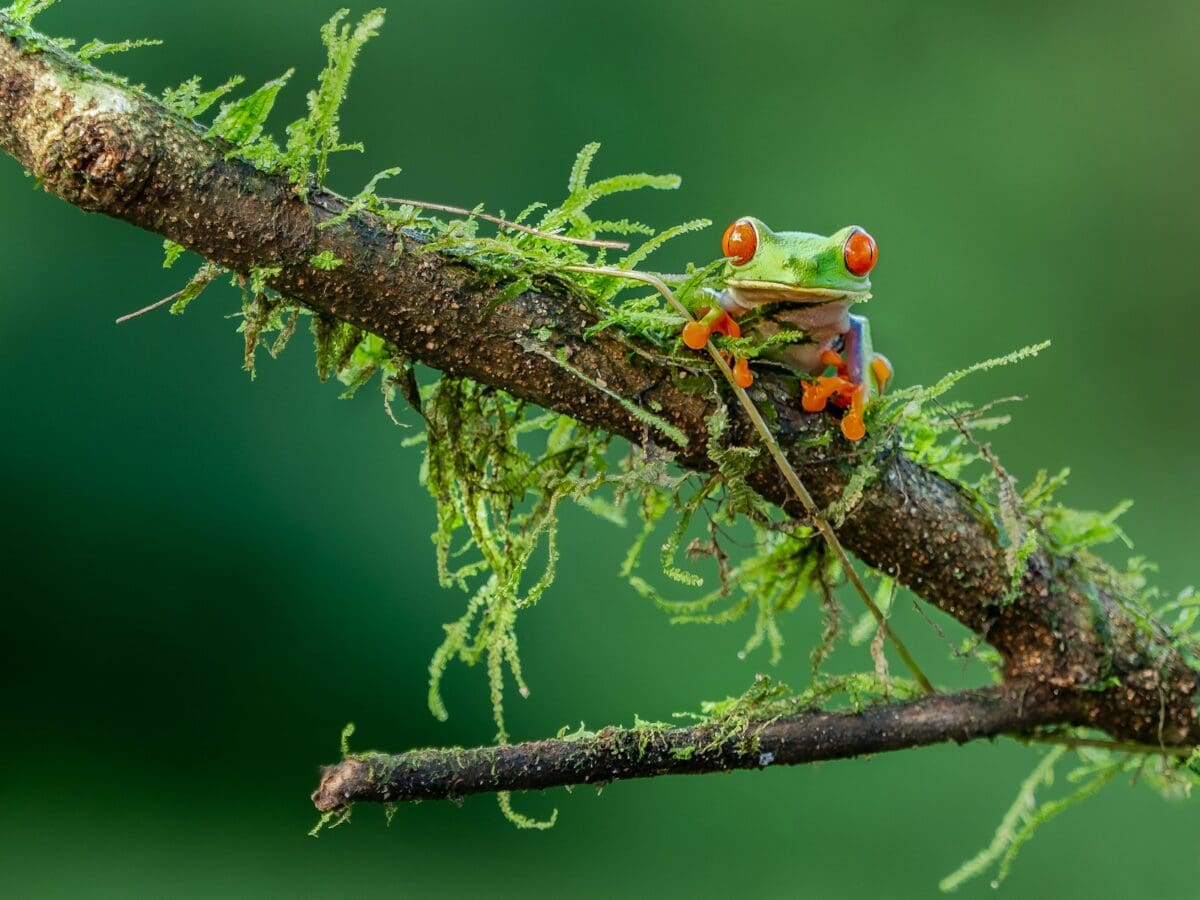
The red-eyed tree frog possesses specialized adaptations that make it perfectly suited for life in the trees. Most notable are their remarkable feet, which feature specialized toe pads covered with thousands of microscopic suction cups. These structures, combined with a specialized mucus secretion, create strong surface tension that allows the frogs to adhere to even smooth surfaces like leaves and branches. This adaptation enables them to climb vertical surfaces, cling to the undersides of leaves, and even stick to glass – a capability that has fascinated both scientists and observers for generations.
Beyond their incredible feet, these frogs have evolved long, powerful legs relative to their body size, allowing them to make impressive leaps between branches – sometimes covering distances more than ten times their body length. Their streamlined body shape reduces air resistance during these jumps, while their flexible spine and muscular structure absorb the impact of landing. Even their skin plays a role in their arboreal lifestyle, being more water-resistant than that of many other amphibians, which helps them retain moisture while living away from water sources in the canopy. Together, these adaptations create a perfectly evolved canopy specialist that navigates the three-dimensional environment of the rainforest with remarkable efficiency.
Unique Reproduction Strategy
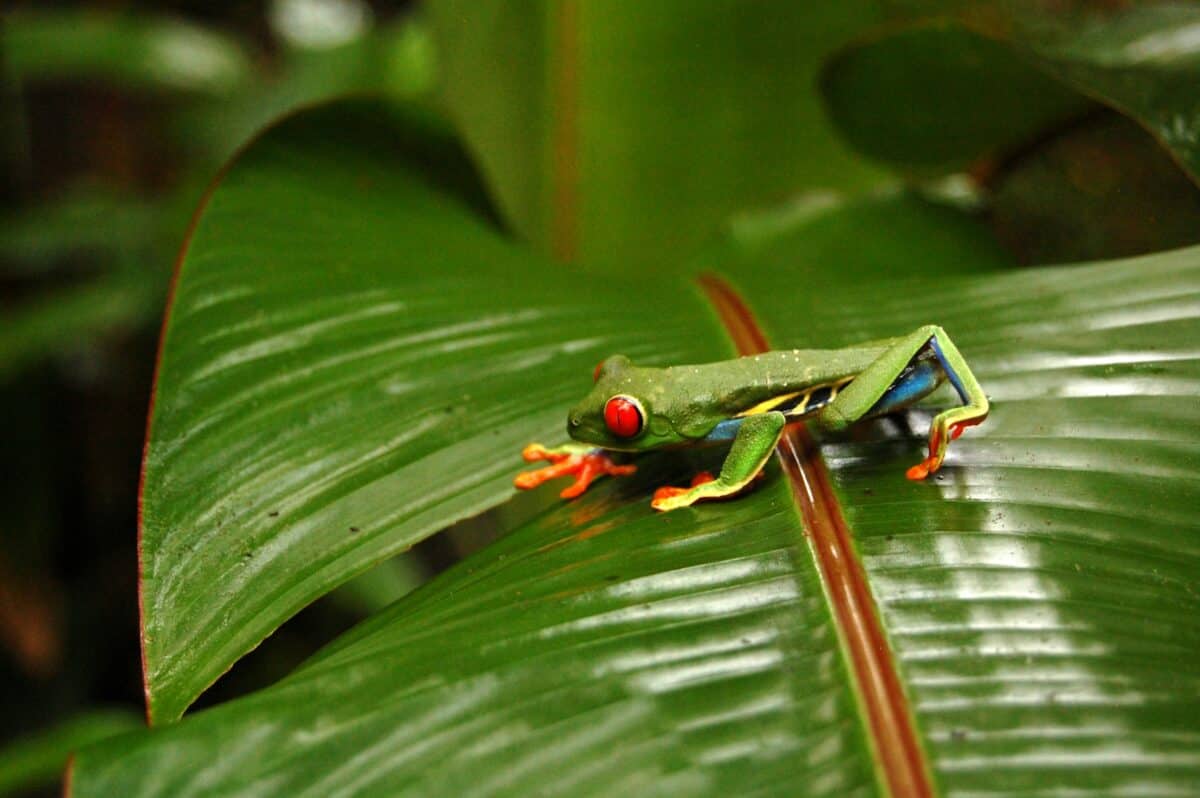
The reproductive behavior of red-eyed tree frogs represents one of their most fascinating adaptations. During the rainy season, males gather near water sources and begin their distinctive calling – a deep, resonant “chack” that can be heard throughout the forest. This calling serves to attract females and establish territory among competing males. When a female approaches, the male performs a complex courtship display that includes shaking branches and producing specific vocalizations. If successful, the pair enters amplexus – a mating position where the male grasps the female from behind, sometimes maintaining this position for several hours.
What truly sets these frogs apart is their egg-laying strategy. The female carefully selects leaves hanging over water sources, where she deposits a clutch of 30-40 gelatinous eggs on the underside of the leaf. This precarious placement serves a crucial purpose – it keeps the developing embryos safe from aquatic predators while positioning them to drop into the water below when they hatch. Even more remarkably, research has shown that the embryos can detect vibrations from approaching predators like snakes or wasps, and can choose to hatch prematurely – dropping into the water below to escape, even if not fully developed. This ability to “emergency hatch” represents one of the most sophisticated predator avoidance mechanisms known in the amphibian world.
The Incredible Metamorphosis: From Tadpole to Tree Frog
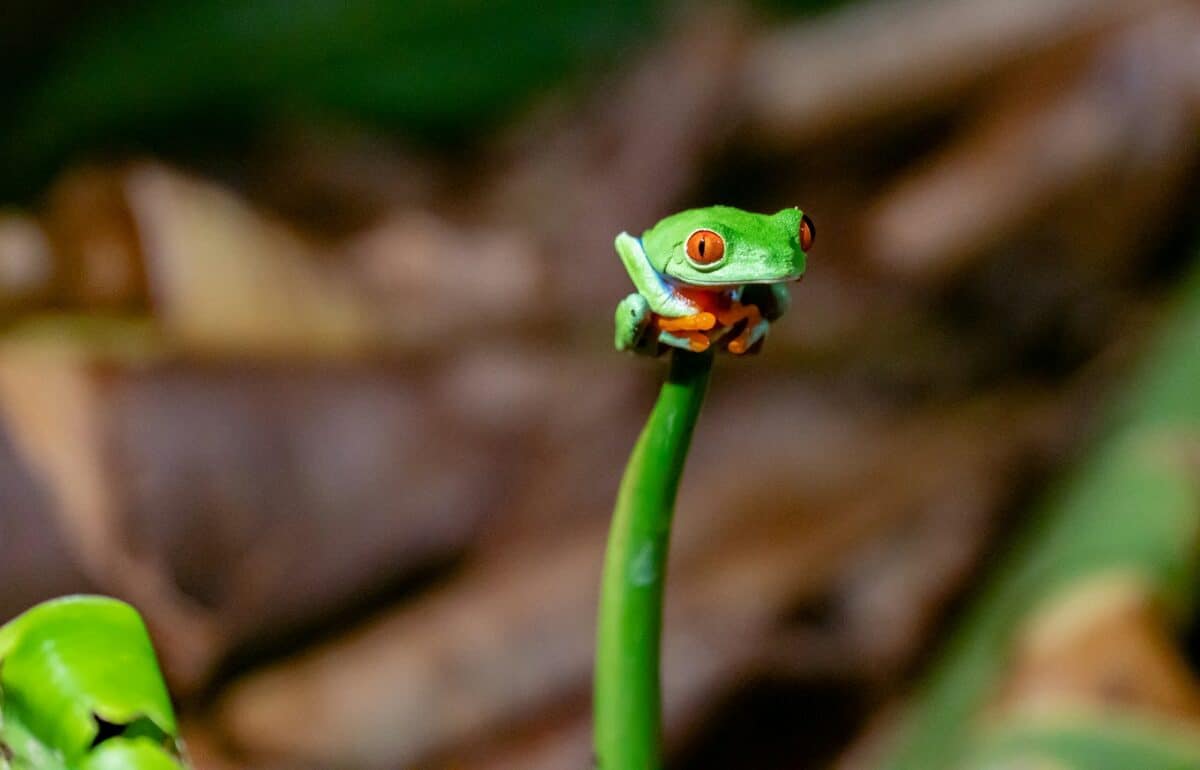
The transformation from egg to adult red-eyed tree frog encompasses one of nature’s most dramatic metamorphoses. After the eggs hatch – typically 5-10 days after being laid – the tadpoles drop into the water below and begin their aquatic life stage. These tadpoles bear no resemblance to their colorful parents, appearing as small, dark, fish-like creatures with specialized mouthparts for feeding on algae and organic matter. During this vulnerable stage, they must evade numerous predators including fish, water insects, and even larger tadpoles of other species.
Over approximately 6-8 weeks, these tadpoles undergo a remarkable transformation. Their tails begin to recede as they develop powerful hind legs, followed by front legs. Their internal organs completely reorganize – gills give way to developing lungs, the intestines shorten and adapt to a carnivorous diet, and the skull and mouth transform to accommodate their future insectivorous lifestyle. Most dramatically, their drab coloration gradually gives way to the spectacular patterns and colors that characterize the adults. When metamorphosis is complete, the tiny froglets, now miniature versions of their parents complete with red eyes and green bodies, leave the water and begin their arboreal lifestyle – a journey that represents one of the most dramatic habitat and physiological shifts in the animal kingdom.
Conservation Status and Threats
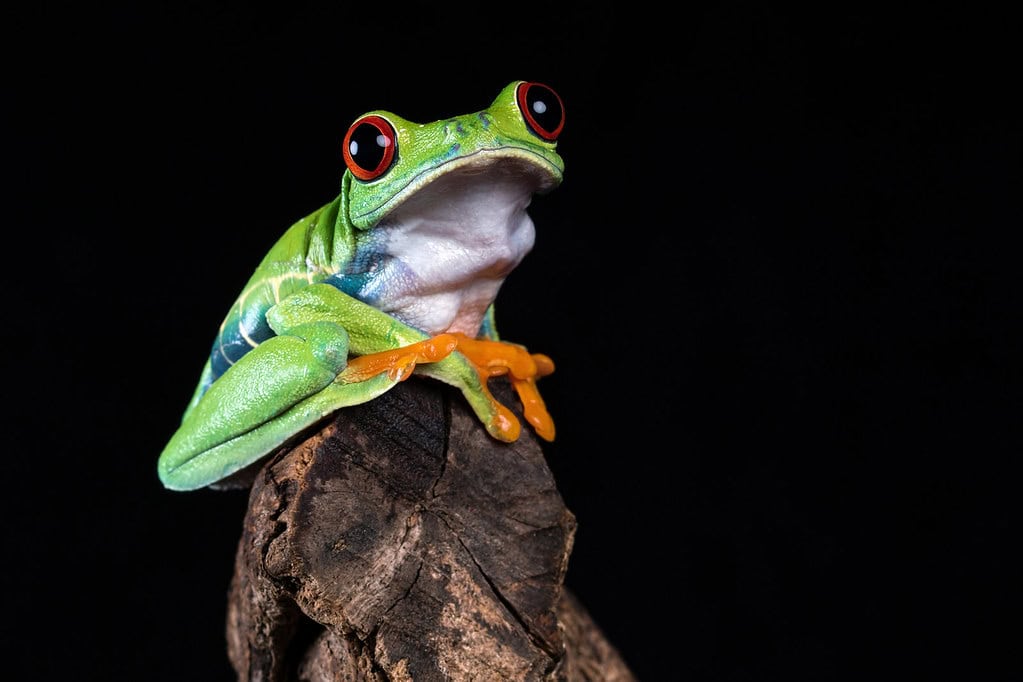
While red-eyed tree frogs are not currently listed as endangered, their population faces mounting pressures that raise significant conservation concerns. Habitat destruction poses the greatest threat, as the specific combination of canopy cover and clean water sources they require is increasingly fragmented by deforestation for agriculture, logging, and urban expansion throughout Central America. Climate change introduces additional stressors, as alterations in rainfall patterns can disrupt breeding cycles, while rising temperatures may affect the delicate environmental cues that trigger reproduction. Disease also presents a growing threat, with chytrid fungus (Batrachochytrium dendrobatidis) devastating amphibian populations worldwide, including those in Central America.
Despite these challenges, several factors work in favor of the red-eyed tree frog’s survival. Their iconic status has made them ambassadors for rainforest conservation, drawing attention and resources to habitat protection efforts. Their relatively rapid reproduction rate and ability to adapt to slightly disturbed forest areas provide some resilience compared to more specialized amphibian species. Conservation organizations have established protected areas throughout Central America that encompass critical tree frog habitat, while education programs in countries like Costa Rica and Panama highlight the ecological importance of these charismatic creatures. Captive breeding programs also maintain genetic diversity and provide opportunities for research that benefits wild populations, though experts emphasize that in-situ conservation of natural habitats remains the most effective strategy for ensuring their long-term survival.
Cultural Significance and Scientific Importance

The red-eyed tree frog has transcended its biological significance to become a cultural icon and powerful conservation symbol. Its striking appearance has made it one of the most photographed and recognizable rainforest species, appearing on everything from postage stamps to tourism advertisements for countries like Costa Rica and Panama. This visibility has elevated the species to ambassador status for tropical forest conservation, with its image used by numerous environmental organizations to raise awareness about habitat destruction and biodiversity loss. In many ways, the red-eyed tree frog has become the unofficial face of rainforest conservation campaigns worldwide.
From a scientific perspective, these frogs continue to provide valuable insights across multiple disciplines. Their specialized toe pads have inspired biomimetic research into adhesive technologies, while their color-changing abilities offer lessons for camouflage applications. Their unique embryonic development and emergency hatching behavior have become important models for studying predator-prey dynamics and phenotypic plasticity. As bioindicators, their population health reflects broader ecosystem conditions, making them valuable subjects for environmental monitoring. Perhaps most significantly, their complex defensive adaptations – combining camouflage, startle coloration, and behavioral modifications – represent a fascinating case study in evolutionary biology, demonstrating how multiple selective pressures can shape a single species into an extraordinary example of natural adaptation.
Fascinating Facts About Red-Eyed Tree Frogs
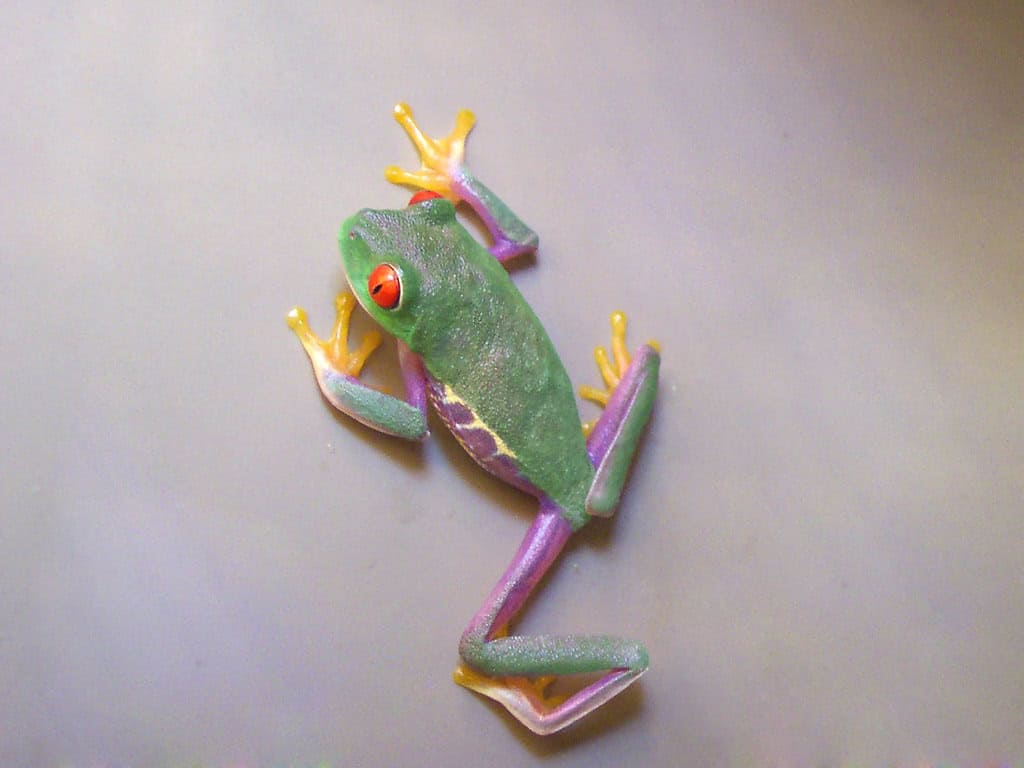
Despite their vivid coloration that might suggest toxicity to predators, red-eyed tree frogs are completely non-poisonous – their colors are purely a bluffing mechanism that mimics the warning patterns of toxic species. Their impressive jumping capability allows them to leap distances of up to 20 times their body length – the human equivalent would be jumping more than 100 feet in a single bound! These frogs also possess the remarkable ability to change their color intensity based on mood, temperature, and health status, with their green coloration becoming darker or lighter to match their surroundings or reflect their physiological condition.
The adhesive capability of their toe pads is so effective that a red-eyed tree frog can support its entire body weight with just one toe if necessary. Unlike many amphibians that require direct contact with water, adult red-eyed tree frogs absorb most of the moisture they need through their specialized skin from the humid air around them, allowing them to spend their entire adult lives in the canopy without returning to water except to breed. Perhaps most surprisingly, despite being one of the most photographed and recognizable frog species in the world, scientists continue to discover new aspects of their behavior and physiology, including complex social interactions and communication methods that were previously undocumented, making them a continually fascinating subject for biological research.
Nature’s Living Artwork: A Testament to Biodiversity

The red-eyed tree frog stands as a vibrant reminder of the extraordinary diversity and complexity of life that evolved in Earth’s tropical rainforests. Its seemingly impossible combination of colors, specialized adaptations, and sophisticated behaviors exemplifies the creative power of natural selection working across millions of years. Far from being merely decorative, every aspect of this frog’s appearance and behavior serves specific survival functions, demonstrating nature’s remarkable efficiency in solving environmental challenges through evolutionary adaptation. The fact that such a small creature can possess such complex and multi-faceted survival strategies speaks to the intricate ecological relationships that define rainforest ecosystems.
As climate change and habitat destruction continue to threaten biodiversity worldwide, species like the red-eyed tree frog serve as powerful symbols of what stands to be lost. Their precarious existence highlights the urgent need for conservation efforts that protect not just individual species but entire ecosystems and the complex web of relationships they contain.
- Eagles vs. Snakes: Who Would Win? - August 9, 2025
- Why Pandas Were Once Nearly Extinct—and How China Saved Them - August 9, 2025
- This Fish Has the Most Teeth in the Ocean—And Uses Them Well - August 9, 2025

